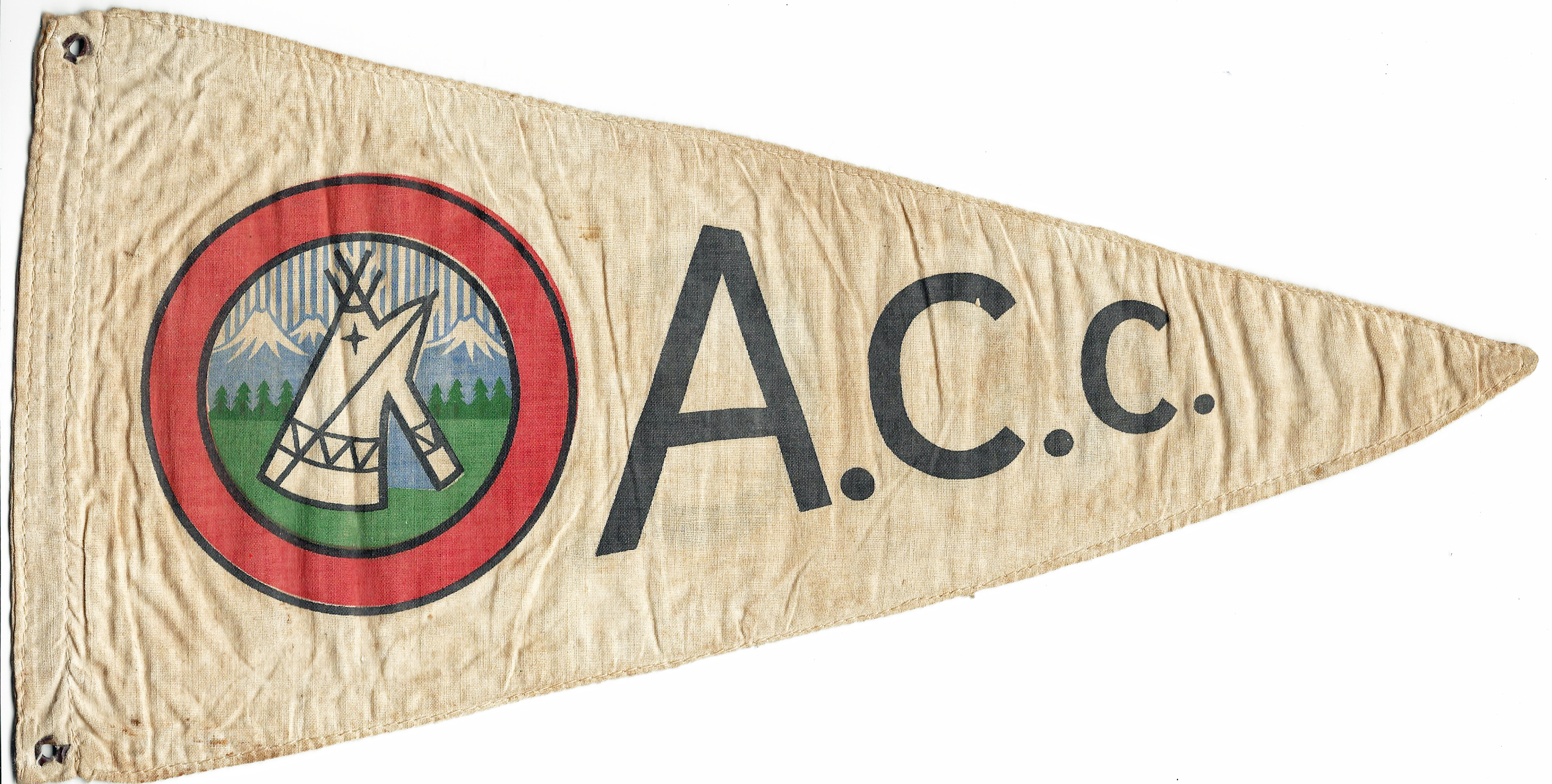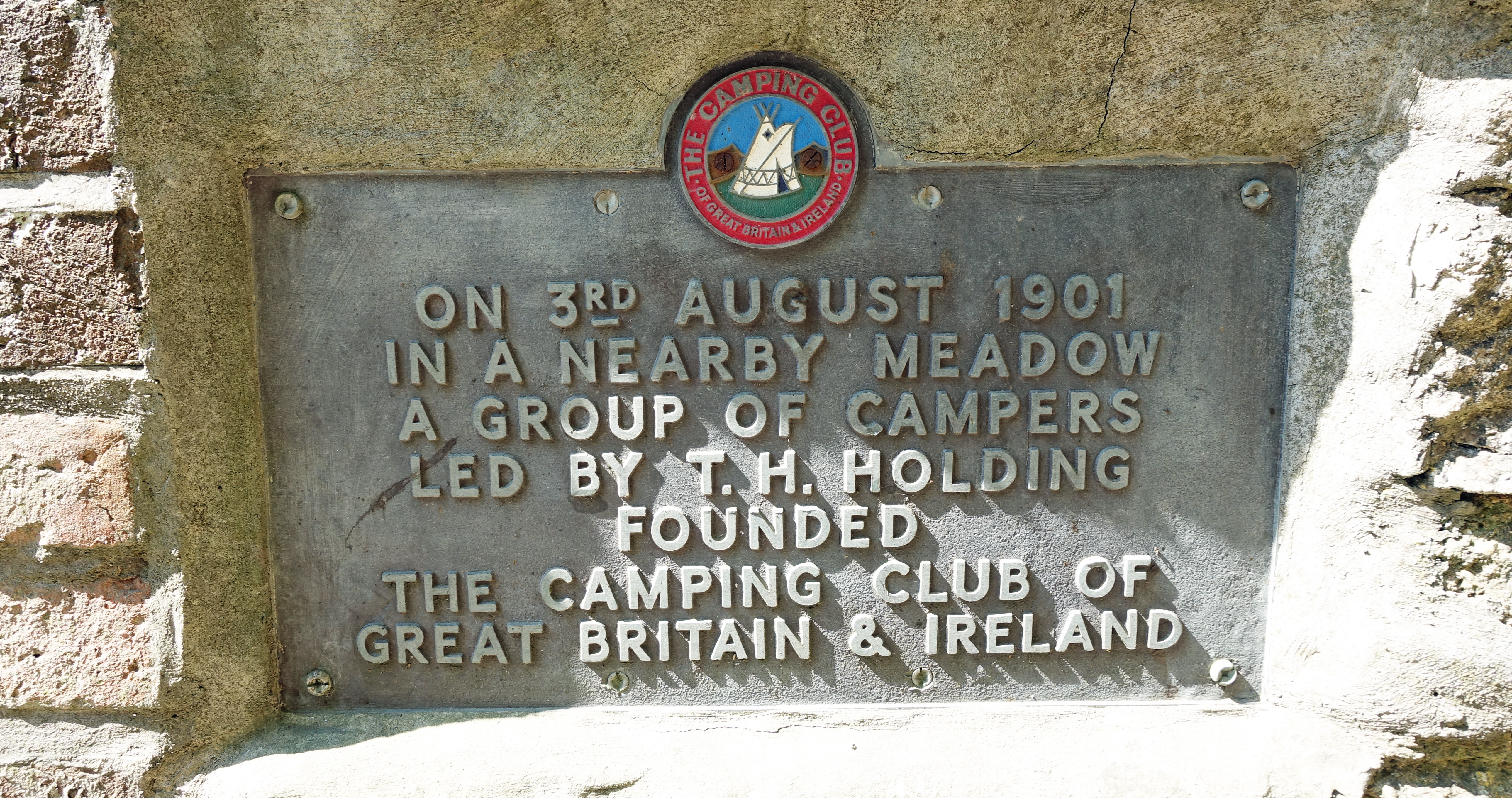Fixed to a stone and brick bridge across Letcombe Brook in Ickleton Road, Wantage is a metal plaque. It commemorates a small gathering of friends many years previous. The ‘group of campers’ mentioned was small, just six in number. That simple coming together of friends, including three brothers, from 2nd -5th August 1901, was the first camp meeting of the oldest such club in the World
Two of the people who had camped in the small English meadow- Thomas Hiram Holding and the Reverend Edward Pitt-Johnson had founded the Association of Cycle Campers earlier that year.
Holding had first experienced camping aged nine when he travelled with his parents across the United States in a wagon train and became the association’s first President. There were thirteen members initially, six of whom attended the first official camp over that four-day August bank-holiday. There were over 100 members of the club the following year and 33 of these, with friends, met for dinner in London in February 1902 to celebrate the beginning of their club. This dinner, or supper, became an annual event and the number of attendees had risen to 92 by 1909. A hundred years later the club was supporting over 500,000 members in their activities.
“civility and courtesy are cheap, but purchase a great deal”
An annual winter ‘Camp Fire’ was established in 1904 with 150 members present at the first winter camp. Even then, there were camping ‘gear-heads’ and improvements in camping gear were avidly discussed. Displays of tents and equipment were arranged. Lectures and lantern slides were organised. From a total membership of 820, around 400 people attended the ‘Camp Fire’ held at West Kensington in March 1910.
“early to bed; but not too early to rise”
From 1909 members could also view ‘lightweight’ camping equipment at the club’s central office in London. The Association of Cycle Campers shared this central office with two allied clubs- the Caravan Club and the Camping Club, the latter was more for those who enjoyed camping but did not use either cycles or motor cycles for transport. The three clubs supported each other and progressed under the designation of the Camping Union. Central office moved from London to Coventry in 1990.
“if some misguided genius should invent a camping equipment that no one could find fault with, half our pleasures in life would be swept away”
An annual Christmas Camp was inaugurated in 1904. Nine members pitched their tents near Chesham. This was not an exclusively male affair as four ladies were amongst the sixteen campers at the Christmas Camp at Cudham in 1909. District Associations were instituted in 1907 with the Birmingham District Association leading the way. Official campsites were created for members- 15 in 1906 of which Weybridge was the first. These had increased to 204 by 1910. One of the most popular of club meets, the Club Feast of Lanterns, was first held in Dorking in 1921. Members of the Caravan Club decorated their caravans with hand-made lanterns.

The Camping Union dissolved amicably in 1909 with the Caravan Club going their own way and the remaining organisations amalgamating and extending their scope to include the needs of pedestrians, pony campers, cyclists, motor-cyclists, motor, caravan, canoeists and boat campers. The new ‘Amateur Camping Club’ was amongst the earliest of organisations formed for all members to enjoy convivial group camping activity. Membership fees were five shillings per annum. The club incorporated the Association of Cycle Campers, the Camping Club and, later, in 1910, the National Camping Club (also formed by Holding). By happy coincidence, the initials of the new association- A.C.C. were already widely known from the predecessor organisation. The Amateur Camping Club was aimed at what they termed ‘light camping’, though the equipment available at the time was no doubt considerably heftier than much available today. In 1910, one member introduced the use of a hand-cart for carrying the necessary camping equipment for him and his family of five that included three small children.

An Ogden’s Cigarette Card series of club badges included the official badge of the Amateur Camping Club in its selection. Also shown on this card is the first ACC Club Pennon, which measured 7 ½” x 13”, the letters A.C.C. were white on a green background with a ‘rosy’ red’ background. The club’s handbook instructed members that- “the cost and weight are very small, and it should always be used, as it adds to the appearance of the tent”. I doubt many campers today are adorning their tent with a flag fluttering in the breeze.
Captain Robert Falcon Scott was President of the Amateur Camping Club from 1909. He took the club pennon with him on his ill-fated journey to the South Pole. Following his death during his return from the pole in January 1912, he was still being recorded as Club President in 1914, news of his death only having reached England the previous year. In 1919 there were 755 members of the club.
“a ready made camping outfit is a delusion and a snare”
The club has always sought to aid not only well established long term members but also advise and welcome people new to the experience of camping. For many years the club stocked just about any piece of kit that the budding camper could wish for. Guides to camping, site lists and general information were regularly published. The Know the Game guide at the head of this post was approved by The Girl Guides Association and, if basic in its limited reach, was nonetheless authoritative, concentrating on safety, comfort, camp hygiene and ‘country manners’.
“choose your camping companions with care”

Various other name changes to the club took place over the years. While the larger tents and caravans are a prominent sight at the club sites today, the club has not forgotten its roots. Revisiting its original 1901 incarnation, in 1944 the Association of Cycle Campers was reformed as a specialised section of the main club. In 1965 this changed to the Association of Cycle and Lightweight Campers and, finally, in 1984, to the Association of Lightweight Campers.- “a special interest section of the Camping and Caravanning Club …. no-fuss camping by cycle, foot or any type of powered transport”
Specialised sub-sections of the club have been created over the years. Cycling, canoeing, mountaineering, folk dance and song were all represented amongst others. There are now nine specialised section. The Boating Group is also affiliated to the Royal Yachting Association.
“don’t expect the use of the whole farm for the sum of sixpence per night”
The caravan section was formed in 1933 and ever increasing numbers of current members are now caravanners. Reflecting this change in emphasis, the parent organisation changed its name to The Camping and Caravanning Club in 1983. The club member’s badge changed in its design and name to reflect this change in emphasis. Yet another enamel badge was made available for members to purchase. Today, some forty per cent of the membership choose touring caravans though one in four of those who own a caravan also own a tent.
The caravan section continued to evolve, not only at last reflecting the changes in propulsion from horsepower to internal combustion but also the growing preference for self-contained and motorised recreational units and a Motor Caravan Section was formed in 1962. An annual meet for members of the sub-group is held. 2022 will see their sixtieth anniversary.
“the best position for a lady to adopt in a tent whilst dressing her hair, is kneeling. There is no difficulty then. If nobody is about, go outside”
Another sub-section was formed in 1967 with the creation of the Trailer Tent Group, the same year that the club held their first Canadian tour.
“re kit:- boil it down”
The club never abandoned backpackers however. Beside welcoming them to the great majority of sites, specific backpacking facilities have also been provided at a handful of locations. The Lake District’s Windermere site, Milarrochy Bay on Loch Lomond and the Hayfield site in the Peak District, provide campers with food preparation areas, indoor and outdoor seating, vented lockers, boot cleaning facilities, bicycle stands and electric points. The latter always appreciated by power starved hikers.
“don’t boast about the set of your flysheet if your tent is full of wrinkles”
“To encourage in young people, particularly those of limited means, a pioneer spirit of adventure, and self reliance and closer contact with nature and the countryside by the practice of camping”
Following on from the Youth Camping Association formed by the club in 1941, a Camping Club Youth section was created to encourage younger campers and this has remained a focus of the club throughout its existence.
Suggested light kit for one, 1910
- single tent with guys, slides and pegs
- poles and pennon
- single groundsheet of proofed material
- eiderdown, with valance to tuck under body
- ‘sirram’ saucepan-kettle stove, windscreen and spirit can
- matches
- small aluminium frypan
- single canvas bucket
- cup, plate, spoon, fork and knife
- aluminium condiment box
- three [proofed bags for bread, oatmeal and tea
- down pillow
- string bags, straps and basket
should not weigh more than 9 1/2 lbs.
“if the weather be fine and warm, there is nothing better in life than to lean over the parapet of the bridge and watch the weeds and the quick fishes”
“if you snore, have a separate pitch”
Club members who had completed 25 consecutive years of membership, and were eligible for state pension, could claim Veteran Membership of the Club. This gave a much reduced membership fee. This has caused vexation amongst members who have racked up considerable years of membership but may have taken a break of a year or two due to circumstances.
In 2019 Three Points of the Compass was completing a hike on the Cleveland Way around the North York Moors and coastline and was drawing close to the nights halt. After a windswept and wet day, I was damp, hungry and looking forward to my booked pitch on the Scarborough Camping and Caravanning site. I knew a hot shower and pristine pitch awaited. I needed to properly rest and recuperate prior to setting off on a further fifty miles across the Tabular Hills. I walked through ranks of caravans and motor units, not a tent in sight anywhere beyond a few awnings. The receptionist apologised and said he wanted to amend my booking, I sighed inwardly and wondered what was coming- “I can give you a special backpacker rate, I’m just refunding your account“. I was soon tucked away on a secluded part of the large site and given exclusive use of a family shower block. Result!
“an old campaigner is known for the simplicity and fitness of his equipment”
This, and other quotes in bold above, are ‘hints and tips’ from-
The Handbook of the Amateur Camping Club, 1914
On hikes still to come, Three Points of the Compass looks forward to the occasional break from wild-camping and will often enjoy nights on the well-appointed sites run by the club, assured of good facilities and a great welcome.
Three Points of the Compass may stick out a little with his lightweight tent amongst the motor-homes, modern caravans and frame tents, but The Camping and Caravanning Club with its many thousands of loyal members really does remain ‘The Friendly Club‘.
In 2001 The Camping and Caravanning Club celebrated its centenary. This second commemorative plaque was placed beside the first plaque shown at the head of this post
There is a timeline of many of the most important or influential UK outdoor organisations on my main website. I will be covering a number of these later in the year. Do have a glance at the list and see where today’s organisations fit in, you may even be able to suggest a glaring omission to the list!






5 replies »